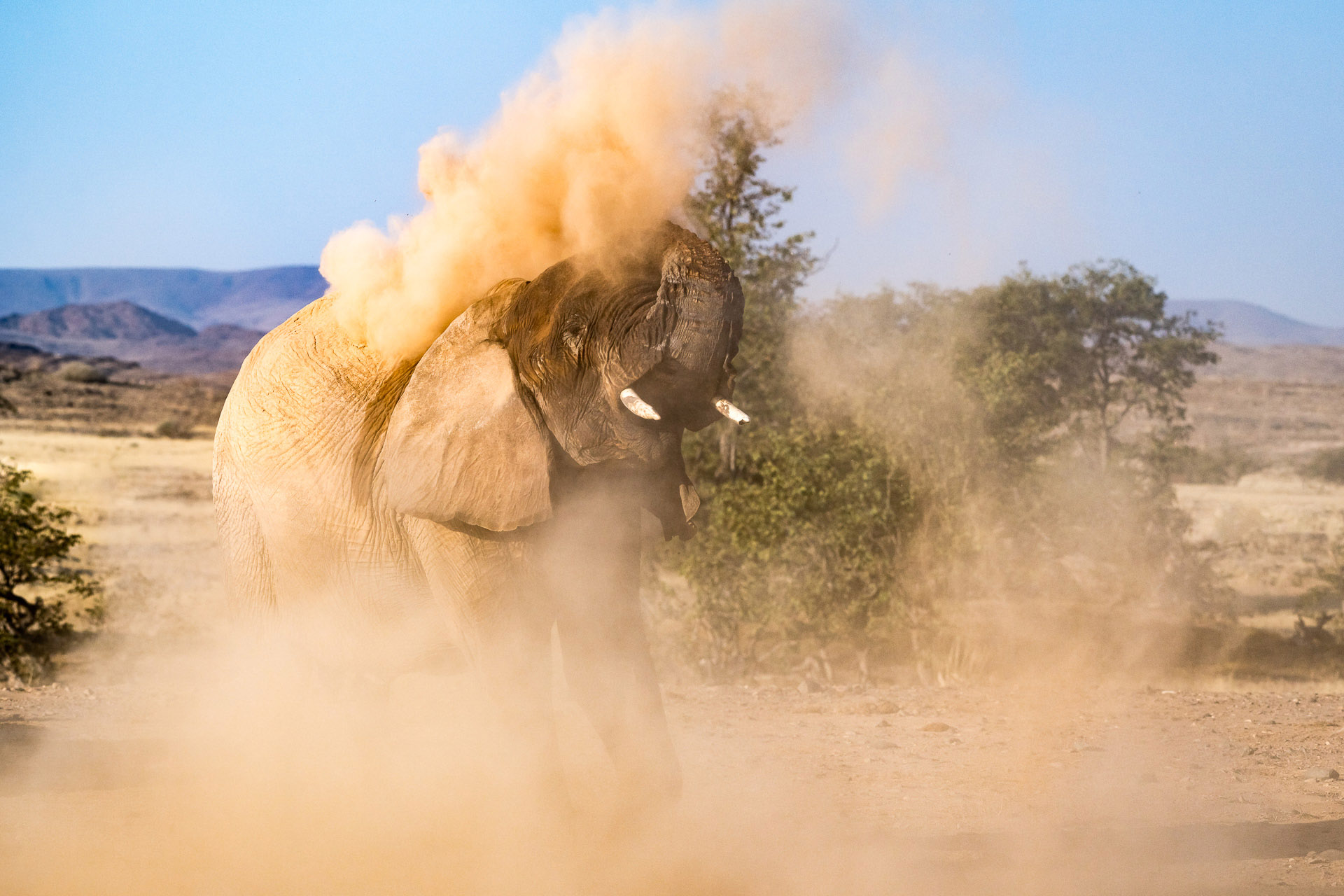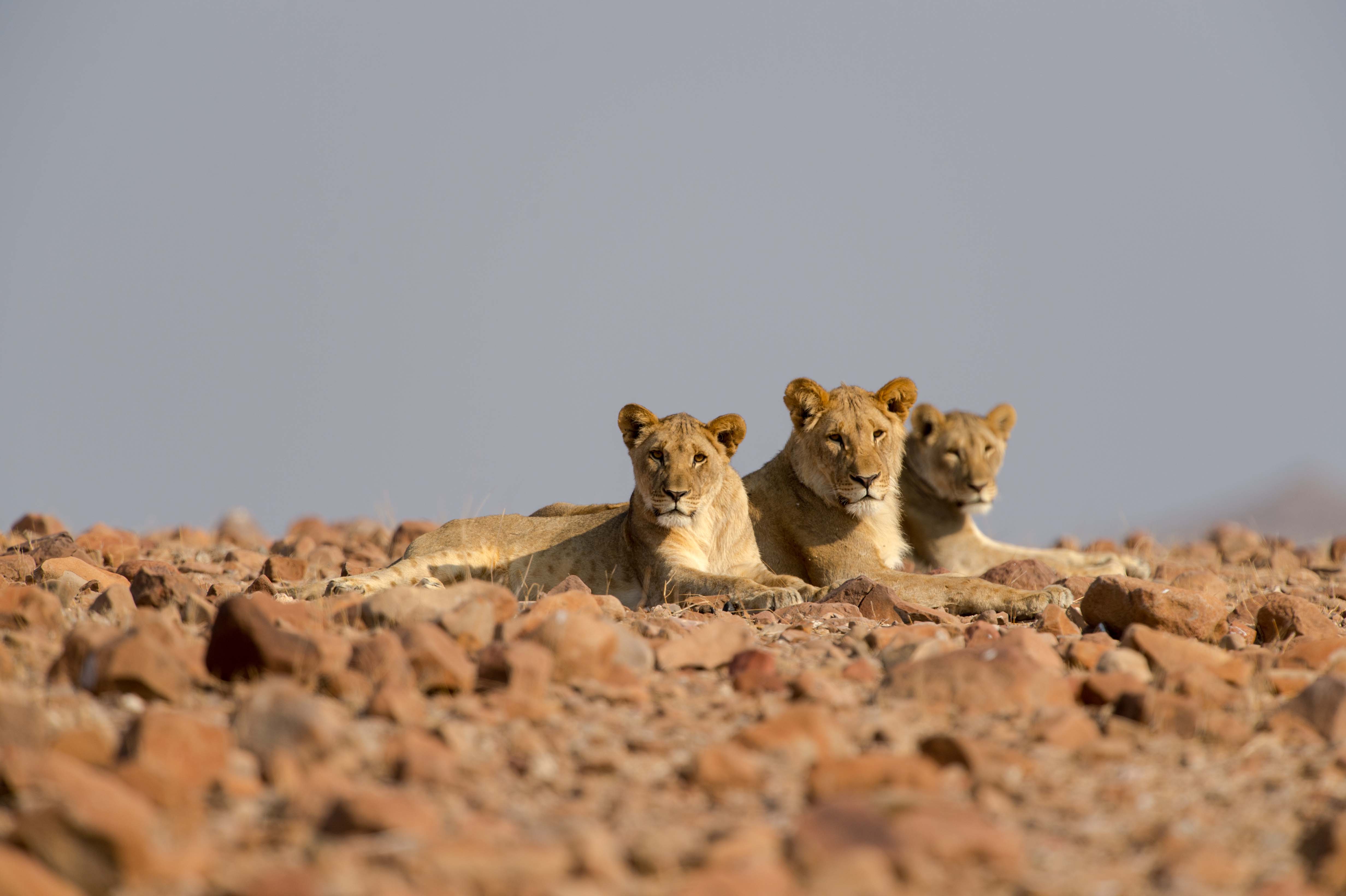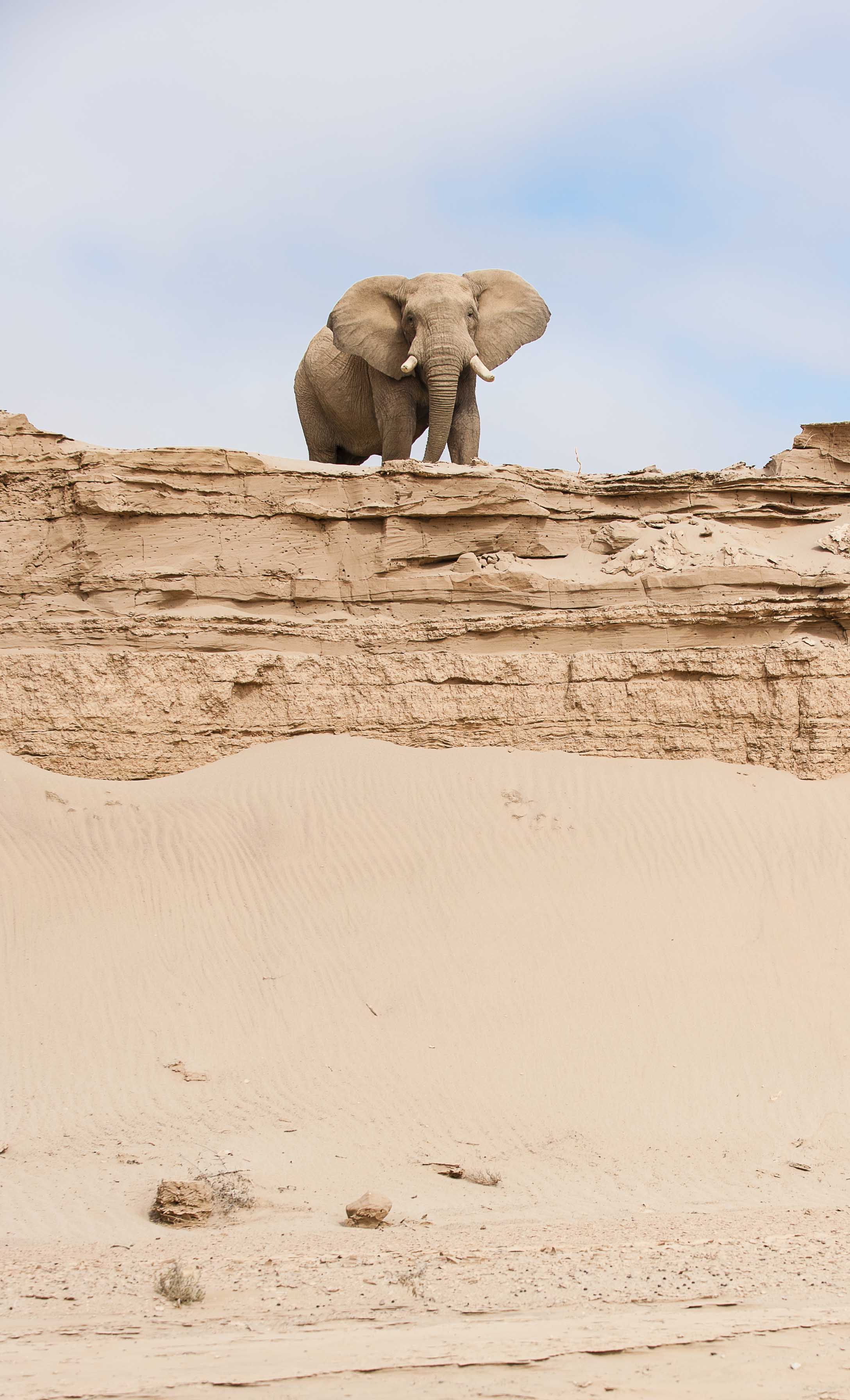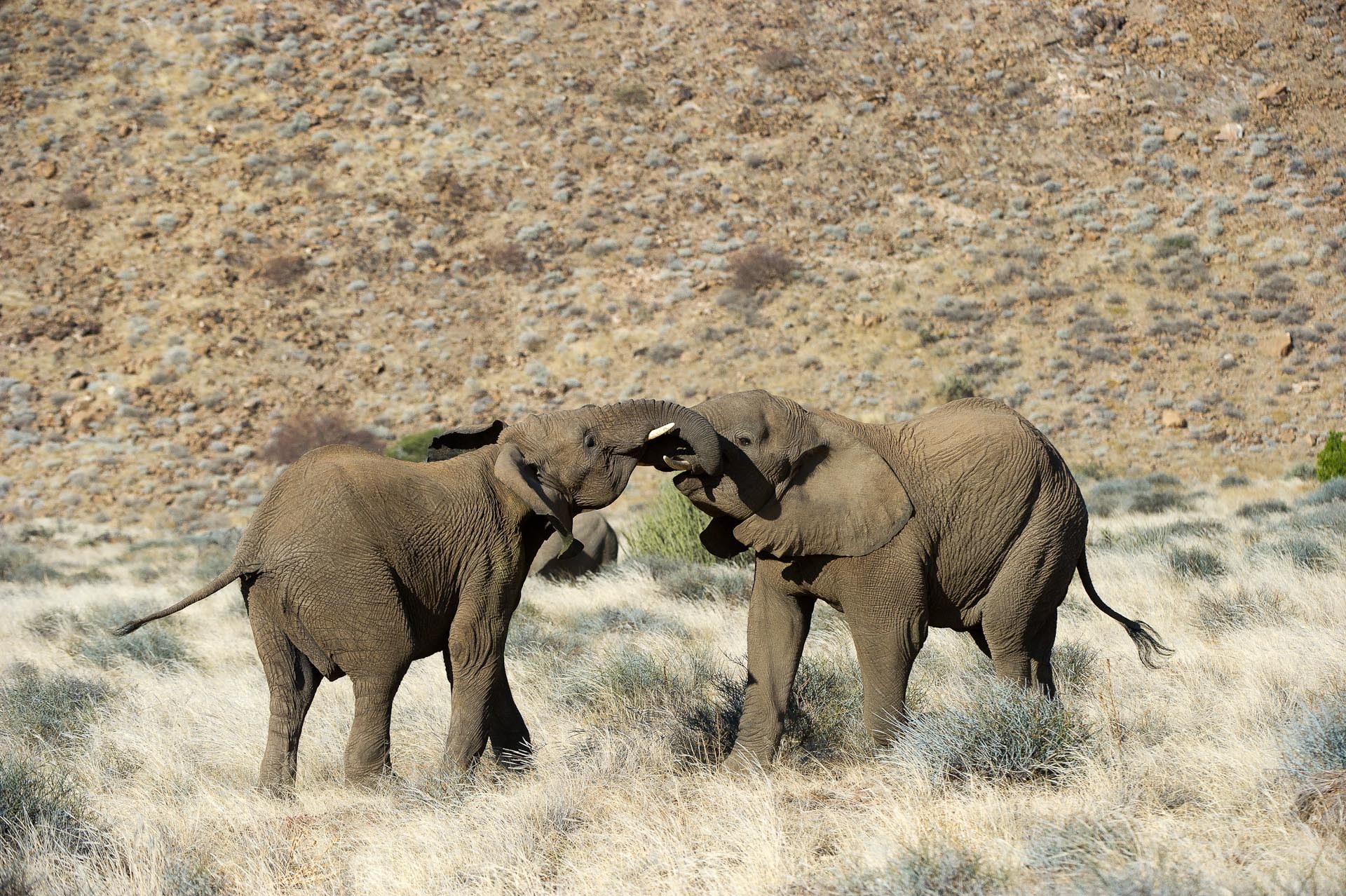It must be incredibly satisfying to spend your days exploring wide tracts of untouched land… In the case of Laura Brown and Rob Ramey this means exploring desert dunes in search of elephants in the Kunene region of north-western Namibia. Both Rob and Laura are wildlife biologists from Colorado, USA, with doctoral degrees in ecology, evolution and conservation biology. Laura and Rob began work in the area in 2005 conducting long-term research on the population dynamics, social organisation and genetics of three sub-populations of desert-adapted elephants. The team is driven by their desire to learn more about these enigmatic animals and will continue their study for as long as possible. “Elephants are long-lived species, and there are deeper questions that can only be answered from this sort of long-term research. There is always more to learn.”
We caught up with the team to ask our questions about these sentient animals, what their study entails and the learnings that have come from observing desert-adapted elephants over the years...

Can you tell me a bit about your study?
We are conducting long-term research on desert elephants – their population dynamics, social organisation and genetics (births, deaths, immigration, emigration, genetic relatedness…) related to three sub-populations of elephants. Our study area is identical to that of Dr PJ Viljoen who conducted the first scientific research on desert elephants from 1977-1983. Thus a long-term comparison of results is possible. We also collaborate with colleagues at Integrated Rural Development and Nature Conservation (IRDNC) who help to educate local communities about the desert elephants in their area, and how to prevent human/elephant conflicts.
Have there been any interesting insights into desert elephants (perhaps behaviours or other) from your study?
One thing that intrigued us about the desert elephants is that they will dig wells in dry sandy riverbeds to access water, even in places where water is readily available nearby, at a borehole for example. Why would they go to all this effort? With our help, our oldest daughter took on this question as a research project, testing bacterial loads in elephant wells versus springs and boreholes, and eventually published a peer-reviewed paper on the results. Not surprisingly, elephants prefer clean water that has not been contaminated by other animals’ faeces, and the sand acts as a filter to remove bacteria. The elephants dig down in the sandy riverbeds to access this cleaner sand-filtered water.
How do you carry out your research?
Over the years we have identified all the elephants in our three study populations (about 80 in total) by taking photos of their ears, tusks and tails and creating a photo ID database. Every elephant is given a number, and some receive names as well, (often having to do with a particular personality trait, so easier to remember). We then locate the herds, and because we know them all individually, we can keep track of whether any have died, or been born, or moved into or out of the area. From that, we also produce an annual census report. Our research is strictly non-invasive, meaning that none of our elephants are radio collared (which would put them at risk). Therefore, our research requires that more effort be put into fieldwork (i.e. searching, tracking, talking to local people and guides, and collecting elephant dung for DNA analysis). We also monitor a network of trail cameras in collaboration with Dr Stander of the Desert Lion Project. These cameras extend our reach across the desert.

What do you enjoy most about working in the country?
We enjoy the wildlife of Namibia’s northwest the most. It’s one of the few places where elephants, lions, and other large game animals can roam freely, outside of a park or reserve. And the landscape is stunning. It is a harsh environment, but parts of it are still very wild and that attracts us. We have also made numerous friends in Namibia, and greatly enjoy spending time and working with them.
Do elephants face any threats in this environment?
Elephants face threats where they come into contact with humans. And unfortunately human populations are expanding into more and more areas, even the desert regions like Namibia’s northwest. Conflicts arise when elephants compete (or are perceived to compete) with humans for the same resources like water, or grazing for livestock. And when there is conflict or intolerance, elephants inevitably lose.
Have there been any particular population trends that you have seen?
In the three sub-populations that we study (Hoarusib, Hoanib, and Uniab river drainages) there are about 80 desert-adapted elephants. In the two river drainages south of our study area (Huab and Ugab rivers), there are another 50 or so. We have seen the desert elephants being slowly whittled away by losses to human/elephant conflict and intolerance, in addition to natural causes. Particularly concerning is the loss of adult males, as the population cannot reproduce without them. And when matriarchs are lost, critical knowledge of the desert is lost with them.

What does a normal field day look like for you?
A typical day is spent driving in search of elephants, which can take many hours, or days, depending on the herd we are looking for and the difficulty of the terrain. Once we find a herd, we spend anywhere from several hours to a couple of days with them. If it is a herd we are not yet familiar with, we concentrate on getting good photos of ears, tusks and tails of as many individuals as possible for our ID database. If it is a herd that we have already identified and know very well, we spend time following their movements and generally observing their behaviours. One can learn a lot about elephant personalities by observing them, and the longer we observe, the more we learn, and the more questions we have about them. That is my favourite aspect of the project: getting to know the elephants as individuals and following their lives over the span of years. Some of these elephants we have known for 12 years, they are like old friends whom we visit on a regular basis, just to check in and see how they are doing.
What challenges do you face when carrying out your research?
Sometimes just finding the elephants is a very big challenge. They are few and far between, spread out over hundreds of square kilometres, in places where there are no easy roads. Just driving our vehicle over very rugged desert terrain is difficult and then there are the regular tyre punctures and occasional vehicle breakdowns in the remote areas we go to. We live out of our 1988 Toyota Land Cruiser and carry all our own food, water and petrol for several weeks at a time. We get to experience the remoteness of the wilderness and camp in some beautiful places sometimes, a huge reward in itself, as is the opportunity to be in the presence of the elephants. Another big challenge for us is the heat during the hot dry season. It is difficult to be productive at times when the temperature climbs above 40°C. The highest temperature we’ve recorded was 51°C, so hot that the computer in my camera stopped working. It was too hot to do anything more than sit absolutely still in the shade of the vehicle and wait for the sun to go down. But the animals were not moving at that temperature either, so we weren’t missing much.
In terms of habitat – do you see differences in foraging behaviours at different times of year?
During the hot dry season the elephants feed primarily on woody vegetation like mopane and acacia. In the cool season, if there’s been a good rain they feed a lot on grasses and forbs. In the Hoanib River there are many Faidherbia albida trees (ana tree), which the elephants love to eat if they can reach the high branches. If there’s been enough rain for a good seed crop, the elephants will spend several weeks trawling up and down the dry riverbed vacuuming up the fallen seedpods. It’s like they’re feasting on chips or crisps, they love the seedpods, which are protein rich.

What are the most notable differences between desert-dwelling elephants and savannah elephants?
The two are the same species; however, the desert elephants are an eco-type, which means they exist in a very unique environment. They remain on the lean side compared to their cousins in the higher rainfall savannah where forage is relatively more plentiful and nutritious. Desert elephants must also maintain a knowledge base of where to find food and water in the vast desert environment, especially on long distance movements between river drainages. Generally the matriarch of each herd is the one who knows the routes to these disparate places, and leads her family at the appropriate time of year, or circumstances (during drought). Desert elephants are living at the edge of what is habitable, therefore they produce fewer calves and these calves tend to suckle for longer periods than savannah elephants. In our population, the average interval between calves is about nine years, with some calves still suckling at eight years of age. In the savannah, elephants can afford to reproduce more frequently and youngsters stop suckling much earlier because plant nutrients and water are more readily available.
Do you have any particular encounters that have stood out for you during your time in the field?
One of the most significant and rewarding encounters we had was witnessing the birth of an elephant calf in 2012. This particular elephant family is well known to us, and allowed us to remain very close, so we took some amazing photos and video. The birth happened very quickly, with just minutes of warning, and then the calf was up on its feet within an hour and trying to suckle. The little one walked 24 km in her first 48 hours of life! Elephants are amazing animals, and the desert-adapted elephants have a tough existence, but they are survivors in one of the harshest environments on the planet, and it is our collective obligation to protect them for the future.

Let’s plan your next journey
Ready?
When we say we’re there every step of the way, we mean it, literally. From planning the perfect circuit, to private inter-camp transfers on Wilderness Air, and easing you through Customs. We’re with you on the ground, at your side, 24-7, from start to finish. Ready to take the road less travelled? Contact our Travel Designers to plan an unforgettable journey.